|

|
Number of versions: 24
Edition: April 2, 2009
|

 Edition: Money-maker,
nr. 209 Edition: Money-maker,
nr. 209
Motel Spiel*Motel game*Motel spel*Joue
de motel
Publisher: Hanky Panky Toys - abt.1977
Dimensions of the box: 32.7 x 43.2 cm
…….……of the board: 41 x 41 cm
The game:
Considering the number of this game it is likely that it is issued in the same
period as the Anti .. jeu – game – spel – spiel ® described
hereafter! Apparently Jack Monschouwer, the owner of the then publishing
house Hanky Panky Toys, had specialized in Monopoly like games, because in this
game also the acquiring of properties (gasstations) is involved, at which
restaurants (white) and motels (red)
can be built.
He also used to make them European Games, because also here
the Service- and All-Risk-cards (comparable with Chance and
Community Chest cards) are in 4 languages viz.: German, Dutch,
English and French. When you draw a Service card you are to pay gas. Some of the
All-Risk-cards say for example: "You buy a new car - pay 5000 euro in
addition" and "You win first prize (?) in Car Rally 1500
euro".
From Start on (where you receive 1600 euro) the gasstations are always in
the West and East side of the following cities: Berlin - Paris - London -
Kopenhagen - Luxembourg - Bern - Milano - Brussels - Amsterdam and Vienna. In
the mid of each side is a gas company, resp.: Shell - Chevron - Esso and
Mobil.
Furthermore there are the 2 spaces Car Repair and Taxi, however at other places
than the Water Works and Electric Company.
The tokens consist of 4
plastic passenger cars and 2 petrol cars. The money consists of Euro
banknotes with the values of 10 - 25 - 100 - 1000 and 5000.
The back of the game board is green.
This set was bought in 1996.
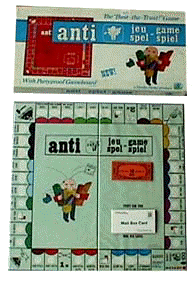 Edition: Anti ..
jeu – game – spel – spiel ®, ref. 212 Edition: Anti ..
jeu – game – spel – spiel ®, ref. 212
The
"Bust~the~Trust!" Game
Publisher: a Hanky Panky product - 1977
Dimensions of the box: 25 x 48 cm
The game:
This game dates from the short period it was forbidden to Ralph Anspach to use
the name Anti-Monopoly. That is why this "fighter against the Charles
Darrow concoction" in America had to take some 40,000 sets of Anti-Monopoly
back from the market. He continued with the same game under the name Anti.
The basic idea of the game is to end off the monopolistic practises of
the 3-company-combinations of the game board. This is also called Trustbusting so the players are called trustbusters. The winning
trustbuster is the one who ends with the largest number of social-credit
points and euro's.
There 3 kinds of company combinations:
-
Oligopoly-combination which is marked by 1 accusation circle O
-
Trust-combination which is marked by 2 accusation circles OO
-
Monopoly-combination which is marked by 3 accusation circles OOO
"Accusing" is done by placing a small, round chip of the same color
as your token on such a circle. When all accusation circles of 1 combination are
covered the monopolistic practises of that combination have been ended. An
accusation chip can be bought for 100 Euro from the "Budget-Commisioner".
If the B-C lends money to a player he provides a Social-Credit card as an
IOU.
There are 36 postbox cards, who give favourable or unfavourable news
like:
 |
"Student volunteers work in your office. You may do your next
accusation free of charge." |
 | "Because of political pressure your anti trust labor is negatively
effected. Remove one of your
accusation chips from the board without
compensation by the Budget-Commisioner." |
Players who land on Court have not to throw double afterwards, because
then "they have been found guilty of insult of the court" for what
reason they have to pay 50 Euro.
This game can be played in 3 different ways:
-
Basic game: In this way the course of the game is ruled by
coincidence.
-
Low-budget game: The trustbusters start with less money.
-
Trade game: Here the trustbusters are allowed to swap accusations.
The back side of the game board is blue.
This game goes with German, English, French and/or Dutch
instructions.
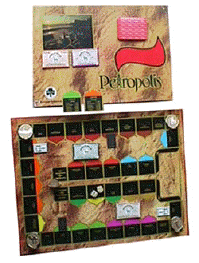 Edition: Petropolis,
ref.nr. 3206 Edition: Petropolis,
ref.nr. 3206
Publisher: KLEE Nürnberger Spielefabrik - 1975/81
Dimensions of the box: 27.3 x 40.1 cm
The game:
The aim of this game is to collect as many oil concessions as possible and to
obtain with that the highest possible profit from the oil producing countries.
Despite the maker of this game calls it a "dice game" it has all the
elements of the well-known Monopoly game.
Start/Landung (= airport of Geneve-Switserland) lies on the midfield and one has to play
counter-clockwise. 27 countries are spread over
the strong game board, each of them having 1 oilconsession to give away.
From the airport onwards the 37 spaces are respectivily:
Venezuela - Argentinien
- Ekuador - USA
- K -Telex - Mexiko
- Gehen Sie zum Internationalen Gerichtshof - Aufanken/Zahlen Sie $ 100,000 - Indonesien
- Brunei Mal - Australien
- China - UDSSR
- Norwegen - Telex - OPEC Konferenz -
Libyen - Algeri
- Nigeria - Gabun
- Falkenjagd in
der Wüste - Internationaler Gerichtshof - Telex - Irak
- Kuwait - Ägypten
- Schardscha - Dubai
- Abu Dhabi - Nochmal würfeln - Gehen Sie
zum Internationalen Gerichtshof - Oman -
Telex -Bahrain - Katar
- Iran - Vermisst
in der Wüste and Saudi Arabien.
Subject to the number of players the consessions are to be distributed amongst
them at the start of the game; the remainder must be sold.
The oilmagnates always move over the board by plane.
Over or on Start you receive P$ 500,000.
The 7 tokens are nice
goldcolored "emblems on a base" with the picture of resp. a Sheik,
oil drums, dromedary, oil storage tanks, swards, plane and tanker.
The money
consists of clumsy tiny (45 x 75 mm) but good looking Petrodollar
banknotes from the Worldbank. In the centre is a circle with a dromedary of
course and the text "In oil we trust". The denominations are
resp. P$1.000 - 5.000
- 10.000 - 20.000
- 50.000 - 100.000
and P$1.000.000
Instead of Chance and Community
Chest cards are here 25 Telex cards with instructions like:
 |
The radar installation of your private jet has broken down. You have to
omit 1 turn. |
 |
You have to appear for the International Court of Justice in The Hague. |
 |
Heavy storm: On all oil-rigs important repairs have to be done. Pay P$
100,000 for each oil-rig. |
The card "Your political influence has helped to prove your innocence.
Keep this card" correspond consequently with "Get out of Jail free". The 2
yellow
spaces on the board are:
"Falconry in the desert"
"Missed in the desert"
They have effect on the game.
This set was bought in 1996.
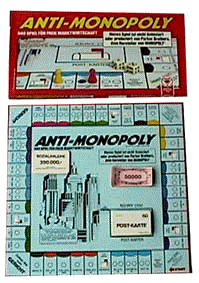 Edition: Anti-Monopoly,
ref. 2136/3 Edition: Anti-Monopoly,
ref. 2136/3
"Das Spiel für freie
Marktwirtschaft"
Publisher: ASS - Leinfelden - 1983
Dimensions of the box: 26.4 x 50.2 cm
The game:
Here again the basic idea of the game is to prevent monopoly building of
companies in order to maintain the foundation of free economy with its
competitors. So the aim is to blow up monopolies, at which the players are Anti-Monopolists.
This version correspond very much with the earlier described "Bust~the~Trust!"
Game, ref.212, but still there are some differences, viz.:
 | not all companies are the same. So Chrystal auto (=Chrysler?) is
here Fauweh (=VW?) and Uni food became Hamburger AG. |
 |
Because all the accusation chips are yellow
each player who was
assigned a combination gets a kind of title deed. |
 |
The back of the game board is red. |
 |
The creaseof the board runs parallel to the first side of the game. |
 |
There is only text on the corner spaces. |
 |
The banknotes have no currency. |
 |
The 6 tokens are hollow, plastic aggravation pawns. |
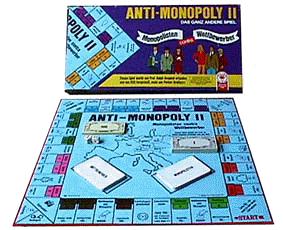 Edition: Anti-Monopoly
II, ref. 2150/5 Edition: Anti-Monopoly
II, ref. 2150/5
"Das ganz andere Spiel"
Publisher: ASS - Leinfelden - 1984
Dimensions of the box: 26.5 x 50 cm
The game:
The cover says strikingly "This game was invented by Prof.Ralph Anspach
and was manufactured by ASS, not by Parker-Brothers!"
Anti-Monopoly II is an improved version of the original game the Atlantic City
Quakers ever called monopoly. Prof. Ralph Anspach invented it and prof. Irvin
Hentzel did the mathematics.
In this game players follow either the rules for monopoly or those for competition
(= Wettbewerb), fixed at the start of the game. Competitors
("Wettbewerber")
charge fair rents, build as soon as they own a property, place 4 houses
at the most, after which they build a hotel
and occasionally go to Price War. On the other hand however "Monopolists"
exort
monopoly-high rents from their poor tenants, build only after they have at least
2 streets of one color, restrict supply by putting only 3 houses on their
properties, after which they also are allowed to build a hotel
and occasionally go to prison.
The good guys are the small entrepreneurs and the bad guys are the
monopolists. Since players do not play by the same rules, fairness is achieved
by a patented technique of equalizing the win probabilities.
Anti-Monopoly II requires more sophistication and strategic thinking than Monopoly because competitors make more money than monopolists in the beginning
of the game but monopolists can catch up later, especially if competitors don't
watch their money. This eliminates a weakness in the other game where one often
knows in the beginning who is going to win, even though the game can drag on for
a long time. Rightly this game is for players as from 10 years.
It is a German game with mainly streets from 4 German cities, but
also from others countries. The cities are respectively Hamburg, München,
Berlin, Paris, Zürich, Wien, London and Frankfurt.
De colors of the streets are from Start: light
green, brown,
lilac, dark green,
blue, purple,
light brown and red.
Electric Works =
Eurostrom en Water Works = Eurogas Gesellschaft.
In the middle of each side of
this blue board you'll find respectively Eurotransport
Gesellschaft, Europabus Gesellschaft, Euroflug Gesellschaft
and Europafracht.
Instead of Chance and Community Chest cards are 25 Wettbewerber and 25 Monopolist
cards. In both cases it are numbered, white cards with funny illustrations and
texts like: "You have won the lawsuit against a Monopolist. Even after
the paying your lawyers terrible high fee, you are still ahead".And for
both: "Go to the Reeperbahn".
Unlike the Dutch version of this game (see
ref.15880) the currency is
not the Euro but undefined. On the properties just houses and hotels are
to be built, but the Wettbewerber pays but half the rent.
The tokens are 6 aggravation pawns of wood.
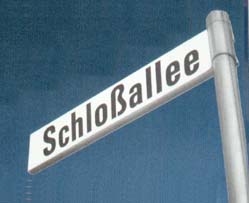 Edition: Bau auf
der Schossallee Edition: Bau auf
der Schossallee
Publisher: Parker Bros./Kenner Parker - 1985
Dimensions of the box: 26 x 50.6 cm
The game:
The subtitle of this game says "Let's go into the world of high investments
and hotel empires" while the "Glückskarten" show an
illustration of Uncle Pennybags on the back. This are sufficient reasons to add
this game, in 1985 issued by Parker Bros., to the collection of Monopoly like
games.
The idea however differs importantly from Monopoly: The board is
oblong: 22.5 x 89 cm and contains 4 colored groups of 5 spaces each, of which
the maximum of 4 players have to collect the properties cards.
The 4 tokens
are respectively: Pram - Roller
skate - Sail boat and a Moped.
There
are 3 dice, one of them being white and provided with a G (Glück), W
(Wunsch)
and one of the colors of each of the 4 spaces on the other 4 sides. Furthermore
are 80 hotel units, 20 per color of the tokens. Dependent on the number
of players each player gets 14 to 20 hotels. He is to build these, subject to
the number of pips thrown, on spaces at choice. The Glückskarten (Fortune
cards) will help. The token is always put on the space that relates to the total
of the property cards the player has in possession. Player can no longer take
part when he has no more hotels. Winner is of course the one who finally has
most properties.
The cover shows a "years twenties"-like illustration of a hotel
entrance with a Rolls Royce-like car. The white bottom of the box shows the long
game board in black and white.
The set was manufactured in France.
Identical games are Advance to Boardwalk (USA), Marble Arch
(GB) and Ga verder naar
Kalverstraat (NL).
The price amounted to DM 35.- (US$ 20.-) in October 1995.
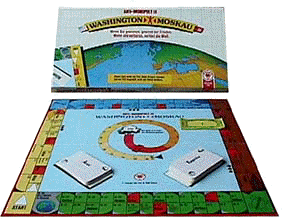 Edition:
Anti-Monopoly
III, Washington-Moskau Edition:
Anti-Monopoly
III, Washington-Moskau
"Wenn Sie gewinnen, gewinnt der
Frieden,
Wenn alle verlieren, verliert die
Welt"
Publisher: ASS - Leinfelden - 1987
Dimensions: 26.5 x 50.2 cm
The game:
Again a different idea of the Anti-Monopoly game that can be played as
from 12 years.
The bottom of the box says:
"Prof.Dr.Ralph Anspach, feighter against monopolies and inventor of
Anti-Monopoly and Anti-Monopoly II has discovered a new field in which
monopolies set the tone:
Today (he poses end of the eighties) the democratic thinking man is faced
with nuclear monopolies and arms race. However it is not right to pose that one
cannot do something about it. Ralph Anspach has converted his ideas into a game
in order to transform that thought. To prevent destruction player has
simultaniously to pursue his own targets as well co-operate with the other
players to maintain peace! Each of the 2 to 6 players represents a nuclear
authority.
The aim of the game is to maintain world peace and to save earth from
falling by a nuclear war. The common target of the players is to prevent the
atom bomb. An explosion of the atom bomb is at the end of the "Arms spiral",
representing the automatism of the arms race. When the "Bomb" arrives
the end of the Arms spiral (in the centre of the game board) world peace
is over and everyone has lost! However, if all players work together in such a
way that 1 reaches the space "Weltfrienden" (World Peace, right
from Start) earlier, then the arms race is over. All players have won and the
one who has contributed the most to maintain world peace is declared winner.
The specialty of this game is the constant conflict players are in: each one can
pursue his personal selfish target to come to a victory, but this selfishness
promotes the arms race. The end is bound to happen. Co-operation is necessary!
But how much co-operation and how much selfishness? May only one be selfish or
may they all? Experience these conflicts yourself!"
And so you can do on a game board that has no streets. On 3 of the 4 sides
of the board you can "turn circles", subject to the instructions you
get on the way. If you are having a lucky streak at your turn you may receive
many millions of dollars, but if it is going against you you may cause the bomb
going 1 or more steps forward! (The cashier also moves the bomb.)
Aktion cards are to be drawn when you land on a similar space. This are a
kind of Chance cards. When you land on one of the red
Krise spaces you are to open one of your 5 Kooperation cards and next
you choose a player of whom you hope he will have an equal card. If that is the
case indeed there are 2 possibilities:
-
He is willing to co-operate. In that case both make a profit.
-
He reports he is not willing to give his card and he plays the
self-seeker. He earns from otherone's turn and moreover the bomb advances
3 spaces.
However, in case the choosen player does not have the card then there is but
1 possibility:
-
You are to go one step back and to pay a fine of some millions of
dollars. Moreover the bomb advances 2 places.
Above each of the 3 first sides of the game board are 3 black dots at
a monopoly-space. Just when 3 black "accusation-chips" have
been put on these the relevant monopoly has been defeated! When a player lands
on such a space while not all 3 accusations have been rewarded, he may do 2
things:
-
He can collect the money he has a right to as a monopolyst. The
consequence however is that also the bomb goes forward.
-
He lodges an accusation. To that end he has to buy a chip from the
cashier.
If you finally land on the fourth green
side of the board the critical phase sets in! Here apply different possibilities:
 |
When a player is on a space of the green
side he doesn't need to throw the dice. Instead he may
buy Accusations
against any Monopoly. |
 |
However, when a player lands on a "penalty space" he has to
return to GR1, the first green space.
At that moment the bomb moves 1 step forward. However, now player may lodge
as many accusations as he wants, but at twice as high a price. Other
players are allowed to help him. |
This intelligent and human game ought to be played World-Wide, but
unfortunately it never got the recognition it deserves.
The American version of this game is called Star Peace, anti nuclear war.
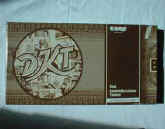 Edition: Das kaufmännische
Talent Edition: Das kaufmännische
Talent
Publisher: Stomo Spiele - Austria - ±1987?
Dimensions of the box: 26 x 50 x 4 cm
The game:
This game is called a European Edition, because the Champs Elysees and the Rue la Fayette
stay brotherly next to Oxford Street and Piccadilly, Kurfurstendamm and Potsdammerstrasse.
In the midfield of the game board are drawn impressions of the cities Hamburg,
Paris, Bruxelles, Berlin, Zürich, Wien and München. (In the Europe
de Luxe version the cities Hamburg and Berlin are replaced by Frankfurt
and London).
Besides these streets are also Plant and Public Transport spaces
where freight charges are to be payed. On the 3 corners
spaces are resp.: Violation of the Law, 10% Capital levy and Arrest. (So the
Jail is at another corner).
The 15 Chance cards and 15 Bank cards are to be put on the centrefield.
The money consists of banknotes as well as round, hard plastic coins.
There are 6 tokens, 32 houses
and 8 hotels.
Remarkable with this game is the cone, a pawn that is to be placed
near one of the numbers 1 to 40 along side 1 of the board to count the number of
playrounds.
The Rules are as well in German as in French.
 Edition: Shalom,
Ref.U1230 Edition: Shalom,
Ref.U1230
Publisher: Uljö Christliche Geschenke - 1990
Dimensions of the box: 37 x 27 x 5.5 cm
of the board: 49 x 49 cm
The game:
The German manufacturer of this very carefully edited game calls it "a
family game with biblical background". Therefore the foreword says "
… the game has to contribute to a better understanding and knowledge of the
word of God." The meaning of the game: "The Shalom game should bring
every individual player closer to the Holy Writ (bible) and so explaining the
connection between the Old and New Testament".
Do we compare this game with the well-known Monopoly we'll see interesting
differences:
|
MONOPOLY
|
|
SHALOM
|
|
Streets from various cities
|
|
2 cities per Stock (=son of Jacob)
|
|
Stations
|
|
Rivers
|
|
Start
|
|
Sinaï mountain
|
|
Jail
|
|
Building of a Tabernacle
|
|
Free Parking
|
|
Song and Shout year
|
|
Go to Jail
|
|
Help to build the Tabernacle
|
|
Chance and Comm.Chest cards
|
|
Old and New Testament
|
|
Money
|
|
Camels and sheeps
|
|
Houses and hotels
|
|
Wells and city walls
|
|
Car, boat, etc.
|
|
Priests (6 wooden tokens)
|
This set is published by:
Uljö
Christliche Geschenke
D-5238
HACHENBURG - DEUTSCHLAND
Website: www.uljoe.de
in
co-operation with Bibel-Center
Freie
Theologische Fachschule
BRECKERFELD
- DEUTSCHLAND
The price amounted to € 29.80.- April 2005.
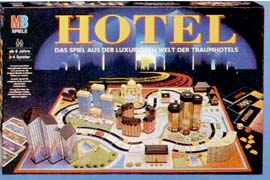 Edition: Hotel,
Ref.14313D Edition: Hotel,
Ref.14313D
"Das Spiel aus der luxuriösen Welt
der Traumhotels"
Publisher: MB
Spiele/Hasbro Deutschland GmbH -1996
Dimensions of the box: 27 x 40 x 9 cm
The game:
The box of this game is rather voluminous because quite a lot of room is
necessary for the 8 hotels, the bank building and the town hall. The
buildings of hotel President and Fujiyama are already skyscrapers. On the game
board a circuit is set having a black edge on each side to put the Entries
for the hotels on. Opposite the Bank is a yellow
line, where you receive DM 2000.- on passing by. The yellow line opposite the
Town Hall entitles to buy Entries. The spaces of the circuit mainly consitst of Purchase
and Building Licence spaces. When you land on a Purchase space you are
allowed to buy a property adjacent to one of the sides of that space.
On a Building Licence space you are to throw the special die:
Red = you don't get the Licence
Green = you have to build now
H = building is free of charge
2 = building cost twice the normal price
Except a main building you also can enlarge with annexes and "Facilities".
The most luxury hotel is finally (!) Waikiki with 4 Extensions and all
Facilities, what makes it a 5-star hotel. The simplest hotel is called Boomerang
and has besides the main building only Facilities (max. 2 stars).
The 4 players obtain their revenues from the other players the moment
they land on a space with an Entry of one of their hotels. To that end the
player throws the normal die again. The number of pips = the number of nights he
has to stay in the hotel. The price for it depends on the number of stars of the
hotel.
The winner finally possesses all hotels.
A very nice game that really do belong to the collection of each
Monopoly
games collector.
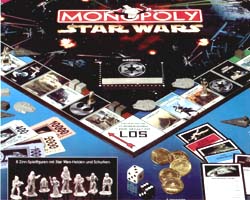 Edition:
Star Wars Monopoly, Ref.Nr.40786100 Edition:
Star Wars Monopoly, Ref.Nr.40786100
"Limited Collector's Edition"
Publisher: Parker Bros./Hasbro Deutschland GmbH - 1997
Dimensions of the box: 25.7 x 51.0 x 5.3 cm
The game:
Again a very nice game indeed that gets the mark "Limited Collector's Edition". The co-operation between Parker Bros. and Lucas Film Ltd. arose
because of the 20 years anniversary of Star Wars.
The most striking of this game are the 2 kinds of players (the Rebels
and Imperials) each having their own
Vehicles and Poperties. The rules
of play are exactly the same as those of the "normal" game, however
the differences are sometimes striking, viz.:
|
MONOPOLY standard
|
|
STAR WARS MONOPOLY
|
|
6 to 10 tokens (hat, car etc.)
Streets with title deeds
Income Tax/Luxury Tax
The money = DM
-
Houses +
hotels
Chance and Community Chest cards
|
|
8 tokens: 5 Rebels, 3 Imperials
Galactic prop. and property cards
Docking tax/Bounty
The money = Imperial Credits
5 brass Imperial coins; 1000 credits each
2 sets of space Vehicles
Imperial and Rebel cards
|
Each token represents a well-known Star Wars character. The Rebel
Alliance is represented by: Luke Skywalker, Princes Leia, Han Solo,
Chewbacca and R2-D2. The fighters for the Galactic Empire are: Darth
Vader, Boba Fett and the Stormtrooper.
The vehicles of the Rebels are the light gray
X-Wing Fighters and Corellian Freighters and those of the Imperials are the
dark gray Tie Fighters and Star Destroyers.
The banknotes are in various colors with the value indication on the
right side. The text with the illustrations on the banknotes is in Aurebesh!?
The bottom of the box not only shows a clear picture of the game board and
attributes, but also a good picture of the tokens: the "Heroes" and
the "Villains".
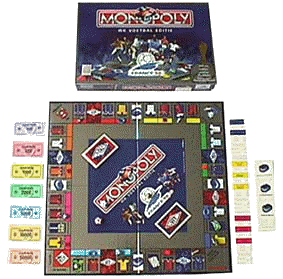 Edition: WM Fussball
Edition France 98,
Ref.19618D100 Edition: WM Fussball
Edition France 98,
Ref.19618D100
Publisher: Parker/ Hasbro Deutschland - 1997
Dimensions: 40 x 27 x 6.5 cm
The game:
This is a box in the colors dark blue, silver
and of course red.
The game board spaces can hardly be found on the cover, but so a couple of
footballers, eachone in an energic posture but not in a match position. On
the bottom of the box is again a clear picture of the game board and its
attributes.
Besides it shows that an inner box as football ground is supplied with
the set. It also strikes that the Ereignis and Gemeinschaftskarten are replaced
bei Aus and Heimspielkarten, with of course matching texts like "Transfer
to Brasil" and "You have missed a penalty. Pay 2000 fine".
The banker's tray is of soft dark blue
plastic and has a special space for the square game board.
In this game
the properties are of course national football teams, viz. those of the 22
best clubs of the official worldlist as it is composed by the FIFA on the basis
of the results of the countries in all worldcup finals since 1930.
On the
game board they are respectively:
Scotland - Switserland -
Romania - Chile -
Mexico - Belgium
- Austria - Czechoslovakia
- The Netherlands - Poland
- Hungary - Yougoslavia
- France - Sweden
- Uruguay
- Russia
- Spain
- England - Argentine
- Italy - Germany and
Brasil.
The spaces have the well-known color bars
and are furthermore characterized by a T-shirt of the concerning country. The stations are replaced by the 4 most important stadiums of France, viz.
Stade Velodrome of Marseille, Stade du Parc de Princes in Paris, Le Stade de
France in Saint-Denis and Stade de Gerland of Lyon.
The 2 public utilities are now Electric Works and Softdrink
Manufacturer (marked
by a red beaker but not of Coca Cola). It
is remarkable that one can be sent to jail in this game as well.
The 8 tokens are resp. a shoe, cap, beaker, hamburger, goal,
whistle, bal and the (gold colored) FIFA Worldcup Trophy (with the
mark "1974 FIFA TM© in the base).
Other differences with the standard Monopoly game are:
|
MONOPOLY
|
|
WM FUSSBALL EDITION
|
|
Income tax
|
|
Transfer costs
|
|
Green
houses and red hotels
|
|
Red
stands and blue stadiums
|
|
Sixsided dice
|
|
Football dice (all figures
double)
|
|
The money is f.e. DM or
Dollars
|
|
The money has no value
|
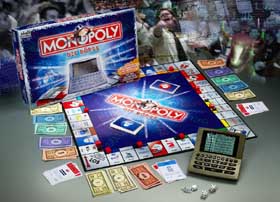
Edition: Die Börse - German, Ref. 16465/100
Publisher: Parker/Hasbro
Inc. - 2001
Dimensions of the box: 6.5 x26.8 x 40.1 cm
The game:
The most significent of this game is its computer that goes with it
(however without batteries). The slogan of this Stock Exchange game
is: "Buy for as low a price as possible and sell
for substantial prices!"
Everything is simplyfied with this computer for the players (every player has
his own entrance button). So they can calculate the exchange rate of their
shares and store the "Presidencies of their compagnies".
The properties of this game are international and national
compagnies that will differ per country. There has been 22 Ereignis
cards replaced by 16 Bear cards and Gemeinschaft
by 16 Bull cards.
The values of the banknotes (ref.nr."100 16465 0000 -
Monopoly Stock Broker") are a factor M (million)
higher and at Los you will receive € 200M. The denominations of these
Monopoly banknotes are resp.: 1M
- 5M -10M
- 20M - 50M
- 100M and 500M.
The 6 tokens are unfortunately the common metal tokens boat -
dog - car - hat - shoe and iron.
The grounds are built with 32 dark blue
branches and 12 red main settlements.
Both dice are white with black pips.
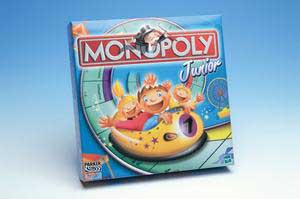 Edition:
Junior standard - German, Ref.Nr. 00441100 Edition:
Junior standard - German, Ref.Nr. 00441100
Publisher: Parker Bros./Hasbro - 2001
Dimensions of the box: 26.8 x 26.8 cm
The game:
Like they did for the 2001 standard edition Hasbro also decided to apply the American
reference number 441 for this new
Junior issue followed by the country number. (The boring uniformity is
consequently applied.)
The presentation on the lid of this square box is
absolutely dazzling indeed. A well streamlined cart whirrling coming
down a twisted roller coaster. Did the red
cart of the 1996 edition show 4 kids now there are but 3 in a yellow
cart. It is also for the first time the red
Monopoly-bar-in-relief with Mr. Monopoly (as Uncle Pennybags is called since
2000) with red bow tie appears out the
central O.
The Rules haven't of course been changed and the oblong game
board has been maintained as well. However, the currency has ofcourse
been changed into €uro.
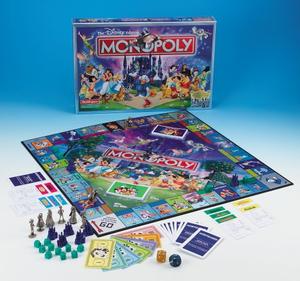 Edition:
Disney Edition, Ref. 090119631100 Edition:
Disney Edition, Ref. 090119631100
Publisher: Parker/Hasbro Inc. - 2002
Dimensions of the box: 26.8 x 40.0 x 6.5 cm
The game:
From Los on all spaces are:
Tarzan - Zauberhafte
Welt - Toy
Story -Steuer an Dagobert Duck - Alladins Fliegender Teppich -
Peter Pan - Showtime - Pocahontas
- Schneewittchen - Gefängnis - Dumbo
- Zauberstab - Die Schöne und das Biest - Arielle,
die Meerjungfrau - Käpt'n Hooks Piratenschiff - Cap
und Capper - Zauberhafte Welt - Bernard
& Bianca - Das Dschungelbuch
- Frei Parken - Steamboat Willie - Showtime -Dornröschen
- Susi und Strolch - Cinderellas Kutsche
- Mulan
- Alice im
Wunderland - Elfenstaub - Cinderella
- Gehen Sie In Das Gefängnis - Bambi
- Aladdin - Zauberhafte Welt - Pinocchio
- Cruella De Vils Auto
- Showtime - König der Löwen
- Steuer an Prinz John
and 101 Dalmatiner.
The Ereignis cards became Zauberhafte Welt cards, while the Gemeinschaftskarten
are here Show Time cards.
The money consists of colored notes with the amount to the left
and the right and Uncle Scrooge inbetween as Mr.Monopoly.
The 8 tokens are Disney characters as they appear in the stories: Peter
Pan - Snow White - Pinocchio - Lady and the Tramp - Dombo - Alice - Tarzan and
Sleeping Beauty.
The set goes with 32 green "White
Rabbit Cottages" and 12 red "Sleeping
Beauty Castles".
The set is "Manufactured in Ireland".
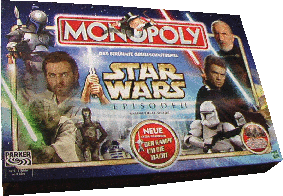 Version:
Star Wars - Episode II , Ref. 47164100 Version:
Star Wars - Episode II , Ref. 47164100
"Sammler Ausgabe"
Publisher: Parker/Lucasfilm Ltd./Hasbro -
Febr. 2002
Dimensions of the box: 26.8 x 40.0 x 6.5 cm
The game:
This is already a 4th version of Star Wars and the 2nd
after a film: Attack of the Clones.
The text on the bottom of the box reads:
"Rush into the fray to rule over the Galaxy!
In this special edition of Monopoly you take part of the great great war
against the Clones yourself. Choose one of the 8 tokens – you decide
yourself if you choose for the Dark or Brite side. Follow an intergalactic way
over the game board meanwhile collecting as many Republican Credits as
possible!
The special "force' die and counters offer an additional challenge
if you have to measure your strength with the other part of the fight for
supreme mastery. Do Obi-Wan Kenobi and Yoda de Jedi je lead to victory? Or
will this be the chance the malicious count Dooku and Jango Fett are waiting
for so long? The one who knows how to prevent a bankrupcy will finally
triumph.
May
the Force be with you!"
The Ereignis
and Gemeinschafts cards have been replaced by
Jedi and Sith cards.
The 8 pewter tokens are: Obi-Wan
Kenobi - Anakin Skywalker - Padmé Amidala - Mace Windu
- a Clone Trooper of the Brite side - Count Dooku - Jango and
a Superfighter droïde of the Dark side.
The currency of the Star Wars banknotes is Republican Credit. The houses
and hotels have been replaced by Appartments and Towers.
Except for the 2 common dice there is also a Force-die supplied
this time.
This German language edition is of
course also available in Austria and Switserland.
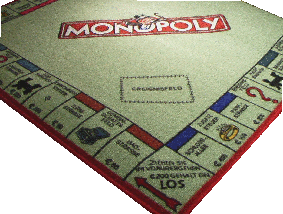 Edition:
German rug game, no Ref. Nr. Edition:
German rug game, no Ref. Nr.
Publisher: Hasbro/Altap B.V.-NL -2004
Dimensions of the rug: 0.93 x 0.93 m
The game:
This rug game is owned by Roland Klose - D.
Except for this German rug, the Dutch firm Altap
B.V. made a same rug of the standard Dutch Monopoly game bord as well.
The rugs go with a set of all standard sized property deeds, Chance- and
Community Chest cards, Monopoly money (Set C, ref.nr. 100 00009 00C0), 32 wooden
houses and 12 hotels,
2 wooden dice with black pips and 6 large (5 cm high) wooden
aggrivation pawns for tokens. Of course the set is accompanied by a Rules
paper.
I once heard of a game player who bought this rug for the only reason this set
was € 5 cheaper than the standard set with ref.nr. 00009.
I think this set gives space for matches of more than 6 players.
This version was only available in the German supermarket PLUS shops under the
art.nr. PLU7154.
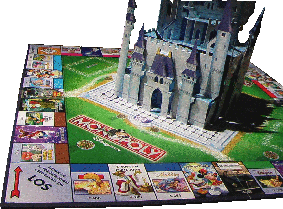 Edition:
Disney - 3D, Ref. 030519631100 Edition:
Disney - 3D, Ref. 030519631100
Publisher: Parker/Hasbro - 2005
Dimensions of the box: 27.0 x 40.2 x 6.5 cm
The game:
This Special Edition is from the collection of Roland Klose - D.
Although this edition has the same reference number as the 2002 issue its presentation is quite different:
 |
The picture on the lid is a new design in which
Scrooge
McDuck is replaced by Mickey Mouse. |
 |
On unfolding the game board a 3D fairy-tale castle
opens
on its centre-field. |
 |
Except for a few exceptions all properties are the
same, but situated in different order over the board. |
From Los on all spaces are:
Bernard & Bianca -
Zauberhafte
Welt - Cap und Capper
-Steuer an Dagobert Duck - Toy Story -
Dumbo
- Showtime - Dornröschen
- Peter Pan - Gefängnis - Alice im Wunderland
- Zauberstab - Susi und Strolch - Schneewittchen und die Sieben Zwerge
- Findet Nemo - Aschenputtel
- Zauberhafte Welt - Pinocchio
- Das Dschungelbuch
- Frei Parken - 101 Dalmatiner
- Showtime - Arielle, die Meerjungfrau
- Bambi - Die Monster AG - Lilo & Stitch
- Mulan
- Elfenstaub - Der Glöckner von Notre Dame
- Gehen Sie In Das Gefängnis - Pocahontas
- Die Schöne und das Biest
- Zauberhafte Welt - Tarzan
- Die Unglaublichen - Showtime -
Aladdin - Steuer an Prinz John
and König der Löwen.
The cards, money and buildings are the same as of the
earlier edition - only a few of the 8 tokens are different. Although the
lid shows but 6+1 tokens the game comes with 8+1, viz.: Alice in Wonderland - Peter
Pan - Mogli - Lady and the Tramp - Dumbo - Pinocchio + a golden Tinker Bell
and (not shown on the lid) Snow White and
Sleeping Beauty.
The story on the back of the box contains two errors in the text, viz.: "... hilfreich
zur Seite chte (ought to be: steht) auf deinen
Besitztümern Hütten und Schlösser und genieße mit Dsney
Monopoly ...". A piece of orange
paper give an explanation of the Special Rule of this game:
In order to make this edition even more magic you shall introduce elf Tinker
Bell:
1. Prepare the game as usual and put Tinker Bell token at the Los-corner.
2. The moment a player throws double Tinker Bell proceeds 1 space. Besides she
jumps over the Tax-,
Showtime- and Zauberhafte Welt-spaces as well as the Jail an
Free Parking.
3. When you lands on a property owned by another player and Tinker Bell is
staying there already, it is the
Banker who pays the rent for you.
4. When you lands on a property that doesn't yet belongs to someone else while
Tinker Bell is there already,
you'll get the property for free.
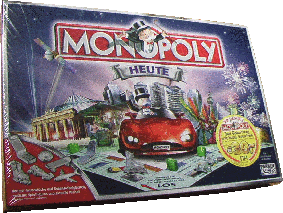 Edition: Heute,
Ref. 020500114/00402/100 Edition: Heute,
Ref. 020500114/00402/100
Publisher: Parker/Hasbro
- Febr. 2005
Dimensions of the box: 27.0 x 40.2 x 6.5 cm
The game:
This edition is from the collection of Roland Klose - D.
I assume Parker/Hasbro
to be a bit in a rush for one reason or the other at the introduction of their 70th
anniversary edition, because
they are confusingly using a double reference number, meaning they
intended from the start to issue 2 different versions.
In this edition the bottom shows this double number 020500114/00402/100,
meaning that this part of the box will also be used for the edition with ref.nr.
00114. And indeed both Heute and Banking show the same green
game board (although the accompanying texts differ) on the box'
bottom.
A rim of the lid however shows the ref.nr. of this issue: 0205.00402/100.
Another slovenliness is the fact that it was forgotten on both "utility
cards" to mention the multiplication factor of 10,000 to be applied. The
correction was made for those cards in the
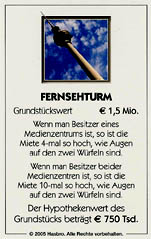 Banking issue. Banking issue.
The motto for this 70th anniversary edition was for all
countries "How would Monopoly look like should it have been invented
today?".
Some countries used this motto for the title of the edition, like France
with "Et si Monopoly était inventé aujourd'hui? (see also chapter www.muurkrant.nl/monopoly/france_-_2005_-_New_streets.htm).
Other countries used names identical to this German one like Here and Now
in England, Itt és most! in Hungary and different like the Van Dam
tot Dom in the Netherlands.
For this version the streets
have been substituted by very well-known (large) objects like buildings,
stadiums and monuments. The amounts
have been made "contemporary" as well. So you will not collect € 200
over Los , but € 2 million instead so a factor 10,000 more. However
everything is of course correspondingly more expensive: The buying price for a
station became f.e. € 2 million.
For all corresponding editions applies in addition:
 |
The blue green
houses
are ellipse shaped and 6 mm in height, have no pointed roof and are
stackable. |
 |
The red hotels have the
same shape but are 31 mm in length. Since they are hollow they are very light
and because of that not very practical. Neighter it is clear what the
purpose of the stackability of these hotels can be. |
 |
The 6 metal tokens are: a skateboard - skeeler -
racing car - a mobile - money bag and airplane. |
 | Besides some countries has an additional token
characteristic for the country. However this German edition hasn't one but
instead a € 30 hotel credit note that unfortunately had a limited
validity till Dec.31, 2005. However, a
little series sold by the Metro Company do have an additional
token: a Brandenburg Gate similar
to the token of the first "European
edition" (Blue
Box) |
 |
The new model banknotes, where Mr.Monopoly seems to
bear a circle with the note's denomination on his hand. All notes show the same10
character number. The denominations are resp.: 10k
- 50k - 100k
- 200k - 500k
- 1M and 5M.
(The whole bundle bears the codenr. 100 00402 0000.) |
 |
The banker's tray, a dark
blue plastic insert in the innerbox has 7 holes for the
attributes. |
 |
The mortgage side of the property deeds is grey.
On the grey background of the Ereignis
and Gemeinschafts cards is resp. a red
question mark and a modern black chest, filled up with (yellow)
gold rods. |
The streets and monuments in Heute are all from Berlin
and are from Los in order:
Checkpoint Charlie -
Siegessäule - Bahnhof Zoo - Oranienburger Strasse
- Simon-Dach-Strasse - Die Hackeschen Höfe
- Im Gefängnis - Tiergarten - Sony-Center
- Olympiastadion - Strandbad Wannsee
- Flughafen Schönefeld - Brandenburger Tor
- Gedächtniskirche - Reichstag
- Frei Parken - Tränenpalast - Museumsinsel
- Berliner Philharmonie - Lehrter Bahnhof
- Kollwitzplatz
- Gendarmenmarkt
- Fernsehturm - Pariser Platz
- Gehen Sie in das Gefängnis - Kurfürstendamm
- Unter den Linden
- Friedrichstrasse
- Flughafen Tegel - Kadewe and Schlossstrasse.
In Germany this anniversary edition was introduced as follows:
 "With
the worldrecord of the largest Monopoly game board ever Parker celebrated
Friday, June 17 in the Berliner Friedrich-Jahn-Stadion the start of
the anniversary the over-dimensioned way: On 900 m2 the Toy
Publisher introduced its new Trend Edition Monopoly Heute, that is launched
right in time. From the motto „How would Monopoly look like should it have
been invented today?“ it hereby goes with modern tokens via Los over
nowadays Berlin scenes, stately penhouses and skyscrapers and players do pay
close to real purchase prices. Those having luck will win a "Wellness Weekend“
from the Ereignis cards stack or may enjoy a "Salary for a TV appearance “." "With
the worldrecord of the largest Monopoly game board ever Parker celebrated
Friday, June 17 in the Berliner Friedrich-Jahn-Stadion the start of
the anniversary the over-dimensioned way: On 900 m2 the Toy
Publisher introduced its new Trend Edition Monopoly Heute, that is launched
right in time. From the motto „How would Monopoly look like should it have
been invented today?“ it hereby goes with modern tokens via Los over
nowadays Berlin scenes, stately penhouses and skyscrapers and players do pay
close to real purchase prices. Those having luck will win a "Wellness Weekend“
from the Ereignis cards stack or may enjoy a "Salary for a TV appearance “."
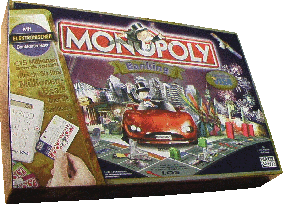 Edition:
Banking - VISA, Ref. 060500114/00402/100 Edition:
Banking - VISA, Ref. 060500114/00402/100
Publisher: Parker/Hasbro -
June 2005
Dimensions of the box: 27.0 x 40.2 x 6.5 cm
The game:
This edition is from the collection of Roland Klose - D.
This edition is basically a copy of Heute, the 70th anniversary issue
with (apart from the date, the first 4 figures) the same double reference
number. The date clearly shows this edition was issued 4 months later than the
original Heute edition.
Underneath the picture of the wrong, green
game board at the bottom side of this box, the right ref. number 0605 00114 100 is
given.
The
real color of the board is silver glossy.
The red car with Mr. Monopoly at the wheel,
only shows the word Monopoly on the licence plate, both on the lid of this
edition as well as on the Heute lid. The licence plate of the French game shows MR. M70,
meaning "Mr.Monopoly's car on the 70th birthday of Monopoly".)
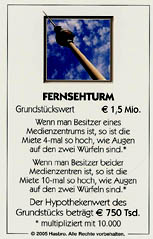 Both "utility cards" now mention the necessary multiplication factor
of 10,000, see the picture.
Both "utility cards" now mention the necessary multiplication factor
of 10,000, see the picture.
Typical for this edition is the card reader. Credit cards replace the
banknotes (which can be ordered should you like to have them as yet).
The credit cards shown on the box however, are misleading. It is suggested they
are chipcards, which is not true. There is but some rise in the card of each
player that is recognized by the card reader. All winnings and spendings are
booked per player in the card reader unit.
All other items as tokens, houses and hotels and dice are
the same as in the Heute edition.
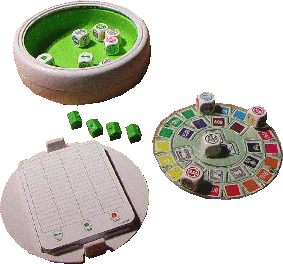 Edition:
Monopoly express, Ref.080542787100 Edition:
Monopoly express, Ref.080542787100
"Der ganze Monopolyspass in 20 Minuten"
Publisher: Parker/ Hasbro - 2005
Dimensions of the box: diam. 15.5 cm x 4.5 cm
The game:
This edition is owned by Roland Klose - D.
This game is just an other presentation, though a nice one, of the
Dice game, like f.e. ref.nr.14087F, issued in 1992 in France and
ref.nr.44029 issued in the UK in 1993.
As the subtitle says: The whole Monopoly pleasure can be enjoyed with this game
in but 20 minutes. There are 11 dice showing not only figures from 50 to
500 but also locomotives and policemen.
On your turn, throw all the dice as many times as you wish to get as many
"streets" of the same color and so get the highest score you can.
However, if you throw all three policemen, your turn ends and you lose all the
points for that turn.
This edition, a non regular item of Hasbro, is "Made in
China".
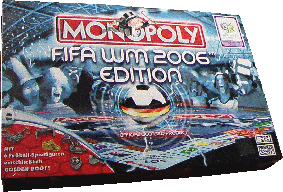 Edition:
FIFA WM 2006 - German, Ref. 010600413100 Edition:
FIFA WM 2006 - German, Ref. 010600413100
"Official Licensed Product"
Publisher: Parker/ Hasbro - 2006
Dimensions of the box: 27.0 x 40.2 x 6.5 cm
The game:
This edition is owned by Roland Klose - D.
The text on the bottom of this set says:
"With this Special Edition Monopoly celebrates the
ultimate sport event of the year 2006: the FIFA football World Championship™
in Germany.
Travel around the FIFA WC game board from one participant country to the
other, buy the teams and build stadiums and tribunes. With the Schiedsrichter-
and Trainer cards you exhort your luck: Perhaps you will win a price, but
maybe you'll get a red card and you have to leave the ground!
Are you ready for kick-off?"
The properties are all off participant countries and from Los
onwards resp.:
Australien - Trainer
- Schweiz
-Rote Karte - Olympiastadion (Berlin)
- Südkorea
- Schiedsrichter - Tunesien
- Polen - Gefängnis - Costa Rica
- McDonalds - Kroatien - Iran
- Fritz-Walter-Stadion (Kaiserslautern) - Deutschland
- Trainer - Japan
- Schweden
- Frei Parken - Italien
- Portugal - England
- Zentralstadion (Leipzig) - USA
- Mexiko
- T-Punkt - Spanien
- Gehen Sie In Das Gefängnis - Frankreich
- Argentinien
- Trainer - Niederlande
- Frankenstadion (Nürnberg)
- Schiedsrichter
- Tschechien - Gelbe
Karte and
Brasilien.
The Chance cards are here Schiedsrichter (arbitter)
cards, while the other cards are Trainer
cards.
The money consists of 7 "Monopoly FIFA WM 2006"-banknotes in
the denominations: 1
- 5
- 10 - 20
- 50 - 100
and 500.
The 6 tokens are: golden boot - keeper - player - goal - ball and whistle.
The houses and hotels are respectively tribunes
and WC Stadiums.
Both dice are 12 sided and show all figures from 1 to 6 twice.
This edition is, as usual, "Made in Ireland".
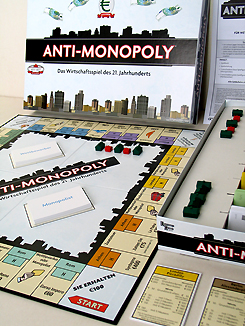 Edition:
Anti-Monopoly®
- German edition, Ref. 08509 Edition:
Anti-Monopoly®
- German edition, Ref. 08509
"Das
Wirtschaftsspiel des 21. Jahrhunderts"
Publisher:University Games Europe B.V.-NL - 2006
Dimensions of the box: 26.8 x 40.2 cm
The game:
On the bottom of the box is, next to a color picture of the game, a short explanation of the origin of the game and
how to play it.
The translation reads:
"An update of the "monopoly" folk game invented by Elizabeth Magie a 100 years ago.
The world-famous game based on our
capitalistic society where private
entrepreneurs struggle for profit.
The same applies for Anti-Monopoly®. Here players also fight to become the
richest real estate and landowner. To attain this
objective, players always
struggle for more power and eliminate their competitors merciless - not exactly
like in real life where
this is tried to prevent.
There competition looks after a functioning market with fair prices.
In Anti-Monopoly® players are divided into two
groups: competitors and monopolists. They follow
different rules as a result of
what the game becomes more dynamic and and richer
in variation."
Ralph Anspach is a Professor Emeritus of Economics
at San Francisco State University who invented this Anti-Monopoly game. He based
his creation on the monopoly folkgame which was invented by
Elizabeth Magie in 1904 and was played extensively in the Eastern United States
between 1904 and 1935. Players in the monopoly folkgame buy and trade properties
to monopolize color groupings.His game transforms the folk game into a battle
between competitors and monopolists and it retains the antimonopoly message of
the creators of monopoly. Quaker teachers (members of the Society of
Friends in Atlantic City, N.J.) transformed the folkgame into what is now played
as Monopoly.
Charles B. Darrow stole the knowledge of the game and its rules from these
Quakers, commercialized it, and falsely claimed that he had invented it to
get an invention patent. He licensed it to Parker Brothers which popularized the
legend of Darrow the Inventor.. .
Ralph Anspach discovered the truth about the history of Monopoly when he
became a defendant in a ten-year long law suit filed by Parker Brothers. He
eventually won that law suit, read his book "Monopolygate".
Anti-Monopoly®'s specialty is, as said, its principle
players have to choose between 2 play methods: that of the Monopolists
and the Competitors. However, which part you will prefer, all players
have equal chances to win, although they play according to different
Rules. So Monopolists for example, can only build houses and hotels when
they have a monopoly position in a town (what is the case
already when the
player owns 2 of 3 streets), while Competitors may build on each property,
independent of they own a whole city or one single street.
On the solid board with black back the streets of 8 cities
are from Start onwards:
 Rom: Corso Impero -
Wettbewerber oder Monopolist - Via Roma - Einkommenssteur (Income
Tax) Rom: Corso Impero -
Wettbewerber oder Monopolist - Via Roma - Einkommenssteur (Income
Tax)
Berlin: Alexanderplatz - Wettbewerber oder Monopolist
- Kurfürstendamm - Potsdammer Straße
Sightseeing-Tour/Preiskrieg(price war)/Gefängnis
(Jail)
Madrid: Plaza Mayor - Elektrizitätswerk (Electric
Company) - Gran Via - Paseo de la
Castellana
Amsterdam: Dam - Wettbewerber oder Monopolist
- Leidsestraat - Kalverstraat
Anti-Monopoly Stiftung (Anti-Monopoly foundation)
Paris: Rue
la Fayette -Wettbewerber oder Monopolist - Rue de la Paix -
Champs-Élysées
Brüssel: Grote Markt - Hoogstraat -
Gaswerk (Gas company) -
Nieuwstraat
Monopoliste: Gehen Sie is das Gefängnis (Monopolist: Go to Jail) /
Wettbewerber: Begeben Sie sich in den
Preiskrieg (Competitor:
Go to the price war)
London:
Park Lane - Piccadilly -Wettbewerber oder Monopolist - Oxford Street
Athen: Wettbewerber oder Monopolist
- La Plaka - Zusatzsteur (Special
tax) - Syntagma
The 4 spaces in the middle of each side are respectively: Flughafen - Straßenbahn
- Bahnhof and Busbetriebe.
The 3 corner spaces clearly have different meaning for the Monopolists and the
Competitors.
Note that this gameboard has the same cities as the French and Dutch edition,
whereas that of the Baltic countries have replaced Berlin by their own capital
city and Finland even replaced Amsterdam and Madrid by two Finnish cities:
Helsinki and Turku.
The bottom part of the box contains a white cardboard insert foulded such
a way that a lower part between two platforms can be used as bankers' tray and
store for the houses and hotels.
There are no Chance- nor Community Chest cards in this game but 2x25
plain, white cards Monopolist and Wettbewerber
instead, all with funny illustrations and always with detailed comment, like:
On the Wettbewerber cards:
 | Die Regierung hat ein strenges Auge auf Firmen, die Anti-Monopol-Gesetze
übertreten. Das ist Ihr Vorteil: JEDER MONOPOLIST ZAHT IHNEN € 25. =
The Government closely see the Antitrust Laws to be obeyd. That is
to your advantage. COLLECT € 25 FROM EACH MONOPOLIST.
|
 | Sie gründen eine neue Firma. WERFEN SIE BEIDE WÜRFEL. 9 oder weniger:
die Firma hat KEINE ZUKUNFT. 10 oder mehr: die Firma
hat ERFOLG, DIE BANK ZAHLT IHNEN € 75. =
You are starting a new company. THROW THE DICE. If you
get a 9 or less IT FAILS. 10 or more: the company is successfully. THE
BANK PAYS YOU € 75.
|
 | Die Monopolisten haben die Benzinpreise erhöht. Dies hat auch auf Ihren
Betrieb Auswirkungen. Der hohe Wettbewerbsdruck verbietet Ihnen
Preiserhöhungen. Ihr Umsatz geht zurück. ZAHLEN SIE € 50 an die Bank.=
The Monopolists have jacked up the price of gas.
Competition does not allow price increases. Your turnover falls. PAY the
bank € 50 . |
On the Monopolist cards:
 | Ihre Politik trägt Früchte. Emissionskontrollen, die Ihren Umsatz
geschmälert haben, wurden mit Ihrem Zutun
abgeschafft. DIE BANK ZAHLT IHNEN € 75. =
Your political contribution was not forgotten. The smoke pollution
controls, which cut down on your profits have
been abolished. THE BANK PAYS YOU € 75.
|
 | Durch einen zweifelhaften Deal ziehen Sie einen großen Auftrag an Land.
Werfen Sie beide Würfel, um zu erfahren,
ob der Deal gelingt. 7 oder weniger DER DEAL IST GEPLATZT! 8 oder mehr ES
HAT GEKLAPPT!
DIE BANK ZAHLT IHNEN € 75.=
Through a shady deal, you landed a big contract. To see whether your deal will go through,
roll the dice. If you
get 7 or less NO DEAL, 8 or more IT SUCCEEDED! THE BANK PAYS YOU € 75.
|
 | Sie haben die Wahlkampagne eines Politikers finanziell unterstützt. Die
Presse hat davon Wind bekommen.
ZAHLEN SIE € 50 an die Bank.=
You made an illegal campaign contribution to a senator. The press got
wind of it. PAY THE BANK € 50. |
It is of course also necessary the two types of players to be taken into
account of on the property deeds. That is why they have 2 columns
for the prices: at the left for the Wettbewerber
and at the right side those for the Monopoliste.
The back side of the cards is also to show the property to be mortgaged. In this
situation the card must be given the bank, however, the owner can any
moment buy it back from the bank. This is also said on the back side of the
cards.
There are only 6 banknotes, printed in grey
on colored paper, in the denominations: 1
- 5 - 10
- 50 - 100
and 500. It is not clear why the Rules say
in bold "all banknotes have to be multiplied by 1000 for their real
value". This is of no importance for the course of the game!
There are only 6 plastic tokens, viz. of each a green
and blue one: cone, pyramid and a pawn like a "cilinder
with sphere".
The set goes with 35 houses and 15
hotels of plastic, with roof rim and chimney. (Note:
The Wettbewerber must place their houses and/or hotels on the name of the field, while the
Monopoliste must situate them on the "H"-spot.)
Both dice are white with black pips.
The first version of this 21st edition was published in 2005 in
the USA, soon followed by that of many European countries.
This edition was "Made in Spain".
The price of this edition was at the introduction € 19.95.
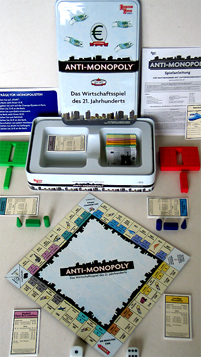 Edition: Anti-Monopoly® - Travel edition in a tin -
German edition, Ref. 08853 Edition: Anti-Monopoly® - Travel edition in a tin -
German edition, Ref. 08853
"Das
Wirtschaftsspiel des 21. Jahrhunderts"
Publisher:University Games Europe B.V.-NL - 2009
Dimensions of the tin: 11.5 x 19.2 cm
of the little board: 18.0 x 18.0 cm
The game:
It will not be too great a surprise that this travel edition is almost an exact
copy of the "long box". But there must of course be
certain restrictions for this smaller version of the game, except for the tiny
game board and the nice tin with its insert of soft, white
plastic. Well, there
are, viz.:
 | The property deeds are smaller: 35 x 60 mm |
 | There are no Wettbewerber, nor Monopoliste
cards, but one small card with 11 instructions for both kind of
players. And
this is the most drastic change, because all stories and
funny illustrations have now been disappeared. The blue
side of the
card has only very resticted instructions for the Monopolists, while
the dark green side shows what the
Wettbewerber
have to pay or do receive. |
 | The banknotes are miniatures (25x45 mm) of those
of the long box. |
 | The 6 smaller, wooden tokens are also in green
and blue, but now resp. a cone - beam
and cylinder. |
 | The 35 houses and 15
hotels (note that the colors has been
changed) are punched from a small block of foam plastic. |
 | The dice are those of the large edition. |
 | The Rules are on 4 pages of A6-size. |
This edition was "Made in China".
The price of this edition was at the introduction € 9.95.
|